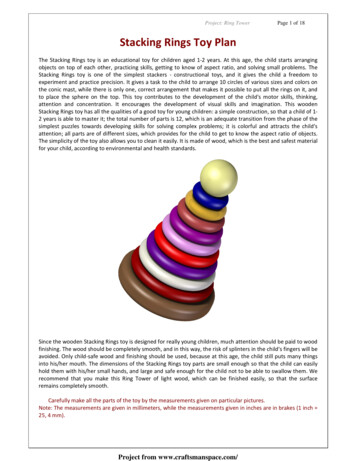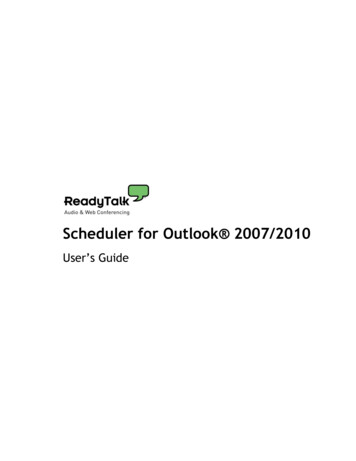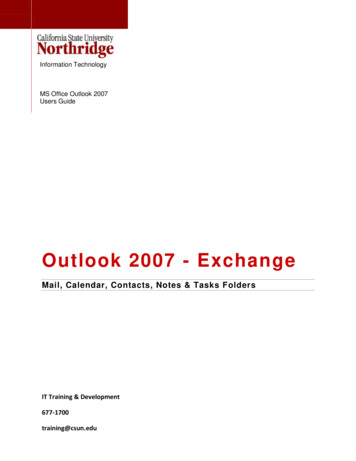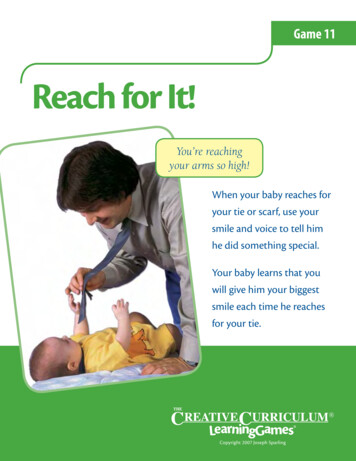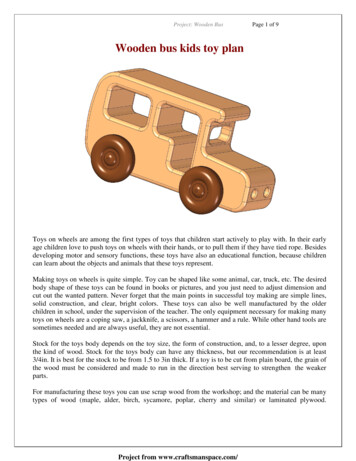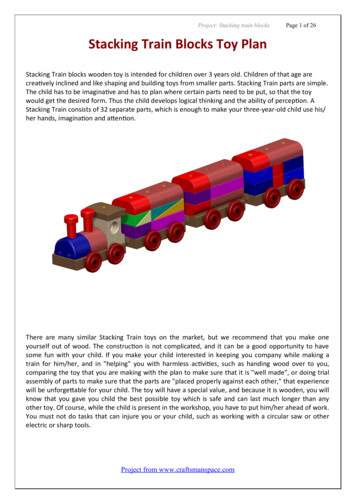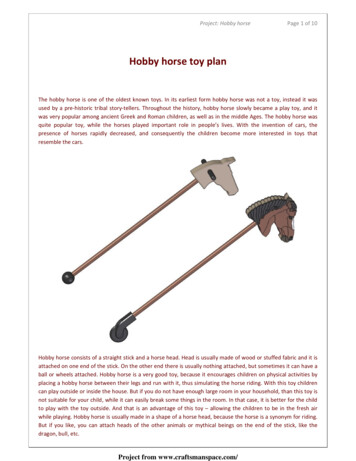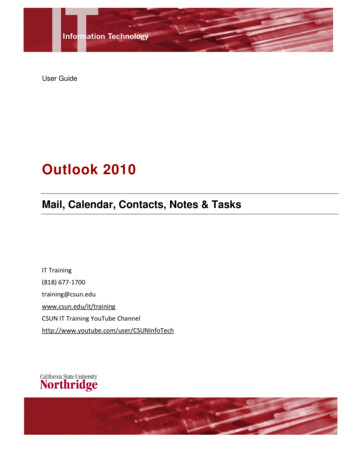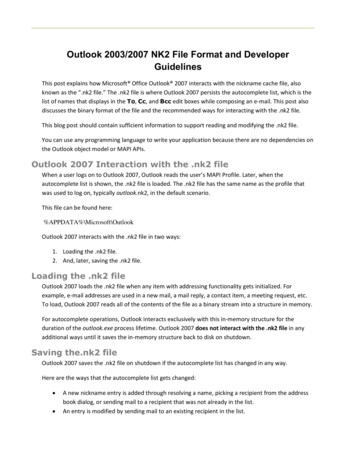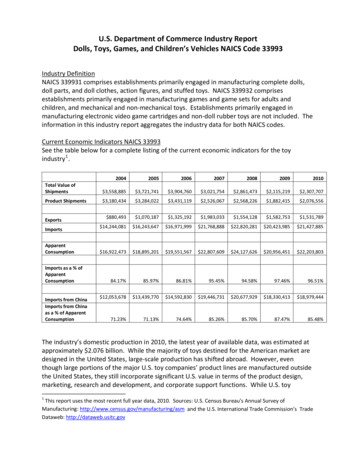
Transcription
U.S. Department of Commerce Industry ReportDolls, Toys, Games, and Children’s Vehicles NAICS Code 33993Industry DefinitionNAICS 339931 comprises establishments primarily engaged in manufacturing complete dolls,doll parts, and doll clothes, action figures, and stuffed toys. NAICS 339932 comprisesestablishments primarily engaged in manufacturing games and game sets for adults andchildren, and mechanical and non‐mechanical toys. Establishments primarily engaged inmanufacturing electronic video game cartridges and non‐doll rubber toys are not included. Theinformation in this industry report aggregates the industry data for both NAICS codes.Current Economic Indicators NAICS 33993See the table below for a complete listing of the current economic indicators for the toyindustry 1 .2004200520062007200820092010Total Value ofShipments 3,558,885 3,721,741 3,904,760 3,021,754 2,861,473 2,115,219 2,307,707Product Shipments 3,180,434 3,284,022 3,431,119 2,526,067 2,568,226 1,882,415 2,076,556 880,493 1,070,187 1,325,192 1,983,033 1,554,128 1,582,753 1,531,789 14,244,081 16,243,647 16,971,999 21,768,888 22,820,281 20,423,985 21,427,885 16,922,473 18,895,201 19,551,567 22,807,609 24,127,626 20,956,451 1% 12,053,678 13,439,770 14,592,830 19,446,731 20,677,929 18,330,413 8%ExportsImportsApparentConsumptionImports as a % ofApparentConsumptionImports from ChinaImports from Chinaas a % of ApparentConsumptionThe industry’s domestic production in 2010, the latest year of available data, was estimated atapproximately 2.076 billion. While the majority of toys destined for the American market aredesigned in the United States, large‐scale production has shifted abroad. However, eventhough large portions of the major U.S. toy companies’ product lines are manufactured outsidethe United States, they still incorporate significant U.S. value in terms of the product design,marketing, research and development, and corporate support functions. While U.S. toy1This report uses the most recent full year data, 2010. Sources: U.S. Census Bureau's Annual Survey ofManufacturing: http://www.census.gov/manufacturing/asm and the U.S. International Trade Commission’s TradeDataweb: http://dataweb.usitc.gov
companies have their own toy development divisions, they also support a network ofindependent toy inventors and designers that sell their concepts to the larger companies. Thelargest U.S. toy trade association, Toy Industry Association (TIA) has resources that toyinventors and designers can use to market their products to manufacturers. TIA organizes oneof the world’s largest toy trade shows. Held each year in February in New York City, ToyFairattracts more than 20,000 attendees and 12,000 exhibitors in 350,000 square feet of exhibitspace.TIA estimates domestic toy related employment at 31,000. TIA member companies employedapproximately 26,215 U.S. workers in 2009. TIA employment figures capture all toy relatedoperations including independent toy inventors and designers. The Bureau of Labor Statistics’Quarterly Assessment of Employment and Wages estimated 2010 employment at 11,886, downfrom 12,881 in 2010. 2 The Census Bureau’s 2010 Annual Survey of Manufactures (ASM) 3 , asampling of manufacturing operations, estimated manufacturing related employment at 9,137.Toy SalesThe U.S. Toy Industry Association, TIA, estimates that U.S. retail sales of traditional toys were 21.78 billion in 2008, up 2 percent from 2009 4 . TIA member companies reported that the toycategories of Dolls, Building Sets and Outdoor & Sports toys saw the strongest growth in 2010,while Youth Electronics, Action Figures & Accessories, and Games & Puzzles saw the largestdrop.TIA estimates that the worldwide retail sales of toys totaled 80.280 billion in 2009 5 . The topten markets by retail sales were: United States; Japan, China, the United Kingdom, France,Germany, Brazil, India, Australia, and Canada. Annual toy spending per child in these marketsranged from a high of 401 in Australia to a low of 6 in India. 62http://www.bls.gov/cew. Major exclusions include self‐employed ndex.html The Annual Survey of Manufactures (ASM) is a samplesurvey of approximately 50,000 establishments.4The term “traditional toys” does not include video games. TIA’s “State of the Industry Table” available ection 12 Rolling Months5TIA commissioned report “Toy Markets in the World: Summary Charts Annual 2009” by the NPD Group availableat: rkets10.pdf6Ibid.
U.S. Exports and Imports of NAICS 33993U.S. trade statistics don’t reflect the global strength of the U.S. toy industry since the majority of toysconsumed in the U.S. are imported or produced regionally to serve specific markets. The U.S. toyindustry exported 1.531 billion in 2010 a decrease of 3.2 percent from 2009.Toys, Dolls, and Games NAICS 33993: FAS Value U.S. Domestic Exports 31337,921315,45820052006In 1,000 8878,699233,321749,717324,323229,555205,271Hong 4Subtotal 891,129,3941,087,6611,135,411All ,7531,531,789MexicoJapan2010 Toy Exports NAICS 33993 (In 1,000)7ITA does not consider Paraguay’s imports of U.S. manufactured toys to be indicative of Paraguay’s domesticconsumption.
The top five export destinations were Canada, Paraguay, Mexico, Hong Kong, the UnitedKingdom, and Chile. Combined, Canada, Paraguay, and Mexico accounted for 53 percent of toyexports.The toy industry imported 21.427 billion worth of toys, dolls and games in 2010, an increase of5 percent over 2010 levels.Toys, Dolls, and Games NAICS 33993: Customs Value U.S. Imports for 86,006In 1,000 Dollars13,439,770 852010 Toy Imports NAICS 33993 (In 1,000)The top five import sources were China, Japan, Mexico, Denmark, and Canada. Chineseproduced toys accounted for approximately 88 percent of all toy imports in 2010.
U.S. apparent consumption of toys was approximately 22.2 billion in 2010 with imports fromChina accounting for 85 percent of the total.U.S. Toy Imports NAICS 33993 vs. Apparent Consumption and Toy Imports from ChinaU.S. and Foreign Toy TariffsThe U.S. toy industry faces relatively low foreign tariffs. U.S. toy tariffs were reduced beginningin 1995, and eliminated by 1999, as part of the GATT Uruguay Round "Zero‐for Zero”negotiations. Other signatories to the agreement include the European Union, Japan, andKorea. Toy trade between Canada, Mexico and the United States is duty free under the NAFTAagreement. As part of China’s accession to the World Trade Organization (WTO), it eliminatedtariffs on most toy categories in 2005.In 2011, Free Trade Agreements were signed with Korea, Columbia, and Panama. Current 2012 averagetoy tariffs 8 on U.S. made toy products are: Korea 4.7 percent; Columbia: 18.5 percent; and Panama:10.4 percent. Toy tariffs in Korea will be reduced to zero upon implementation of the agreement. Toytariffs in Columbia will decrease to 0 percent after a 10 year staging. Toy tariffs in Panama will bereduced either upon implementation, or using a five or ten year staging period.In December 2011, Russia was invited to join the WTO as the 155th member. After fullimplementation of its WTO commitments, toy tariffs which range from 5‐20 percent will bereduced and bound between 5‐15 percent depending on the product category. Russia isexpected to formally join the WTO in 2012.8Toys are defined as chapter 95 of the U.S. Harmonized Tariff Schedule. Specific toy rates provided in this reportare for headings 9501, 9502 and 9503. FTA Tariff rates for other headings are available through the Departmentof Commerce’s Free Trade Agreement Tariff Tool.
U.S. toy companies still face tariffs ranging of up to 10‐20 percent in South American countriessuch as Brazil, and Asian countries such as Indonesia, Vietnam. For current tariffs on U.S.products contact the Trade Information Center or call 1‐800‐USA‐TRADE.While U.S. toy companies generally enjoy relatively low tariffs in key export markets, they canstill encounter non‐tariff barriers to these same markets. Companies that encounter problemsexporting are encouraged to report their problem to the International Trade Administration’sTrade Compliance Center. The U.S. Department of Commerce working in conjunction withUSTR and the Commercial staff at Embassies abroad have resolved numerous non‐tariff tradebarriers for U.S. companies including issues pertaining to import licenses, safety standards, andlabeling requirements.Industry Legislative Changes and Toy RecallsIn 2007, more than 45 million toys and other children's products were recalled for hazards suchas lead paint and small powerful magnets that could injure children if swallowed. Stakeholders,including toy manufacturers, retailers, and consumer groups, participated in numerousCongressional hearings which resulted in significant changes to the standards and testingprocedures applied to domestically produced and imported toys and children’s products. OnJuly 31, 2008, Congress sent President Bush a compromise bill, H.R. 4040, entitled “ConsumerProduct Safety Improvement Act of 2008. The Act impacted the U.S. toy industry in thefollowing ways: Children’s products that contain lead above 600 parts per million for the first year,reducing to 100 parts per million beginning the third year following the enactment of theAct, will be treated as banned hazardous substances. The limits represent some of thelowest lead limits in the world and effectively bans lead from children’s products.Third party testing and certification for certain children’s products will be mandatory.Children's products will be required to bear tracking labels that would allow their pathfrom factory to store to be more easily retraced in the event of a recall.Toys and games advertised for sale on the internet and in catalogs will be required toprominently display the same cautionary language included on product packagingThe voluntary industry standard ASTM F‐963 will become a mandatory standard overseenby the Commission.Phthalates are a group of chemicals added to plastic toys and other plastic products tomake them soft and pliable. The phthalates DEHP, DBP, and BBP would be banned aboveconcentrations of 0.1 percent. Until the results of a Chronic Hazard Advisory Panel havebeen received, the phthalates DINP, DIDP, and DNOP will be banned above concentrationsof 0.1 percent in any children’s toy or childcare article that can be placed in a child’smouth.The Consumer Product Safety Commission website has numerous informational resources tohelp stakeholders understand how the Act’s requirements will be implemented includingdownloadable video files of recent public meetings and timelines which summarize therequired actions pursuant to the Act.
The APEC Toy Safety InitiativeThe APEC Toy Safety Initiative was the U.S. response to the many notable toy recalls of 2007,and to APEC Leaders’ calls in 2007 and 2008 to “strengthen consumer product safety standardsand practices in the region” and “to undertake work to ensure the safety of toys.” The projectwas managed by the U.S. Department of Commerce’s Office of Health and Consumer Goodsand the ITA’s Standards Liaison in conjunction with USTR. The Initiative was cosponsored byseven APEC economies: Chile, China, Chinese Taipei, Japan, Malaysia, and Viet Nam. TIA wasthe U.S. private sector partner and contributed half of the operating funds. The Initiative calledfor a survey of current toy regulatory practices of all APEC member economies and two events:“A Regulator Dialogue on Toy Safety,” held on the margins of the Singapore SCSC meetingAugust 1‐2, 2009; and “An Open Dialogue on Toy Safety for All Stakeholders” (Open Dialogue)held during the Hong Kong Toy Fair on January 12, 2010.The two Dialogues marked the first‐ever meetings of all toy industry stakeholders within theAPEC region (home to over 85% of all toy manufacturers and exporters) to discussopportunities and obstacles to global standards alignment. The Singapore meeting wasattended by 130 regulators from 20 of the 21 APEC economies (only Russia was notrepresented). The Hong Kong meeting was attended by 214 people representing regulators,standards bodies, toy manufacturers, retailers, toy associations, testing companies, and othergovernment representatives. Non‐APEC attendees included Belgium, Denmark, India, Swedenand Switzerland. There was discussion of the regulatory systems of 15 members, and therelationship between the three main toy standards, ASTM F963, the EU’s EN‐71, and ISO 8124.Key Outcomes from Singapore Commitment to participate in a survey of member economies regarding toy safetysystems as a deliverable to the Hong Kong meeting. Agreement between the ASTM and ISO technical committees to consultations onemerging toy safety hazards.Key Outcomes from Hong Kong 9 Completion and endorsement of the APEC Toy Safety Survey and circulation of thedocument to the OECD, WTO TBT Committee and related organizations. Agreement by APEC members to continue to pursue standards alignment in allstakeholder groups through an industry task force, international regulator forums, andconsumer organizations under the auspices of the APEC Toy Safety Initiative. Commitment by CPSC to dedicate resources for global toy standards alignment in its2010 workplan entitled “Plan for International Coordination on Toy SafetyRequirements” (released May 2011).Questions related to this industry report should be directed to the toy industry analyst atJamie.Ferman@trade.govUpdated 1‐24‐20129Key Documents from the Hong Kong meeting are available on the TIA cfm?Section APEC Meeting
The U.S. Toy Industry Association, TIA, estimates that U.S. retail sales of traditional toys were 21.78 billion in 2008, up 2 percent from 2009. 4. TIA member companies reported that the toy categories of Dolls, Building Sets and Outdoor & Sports toys saw the strongest growth in 2010,
